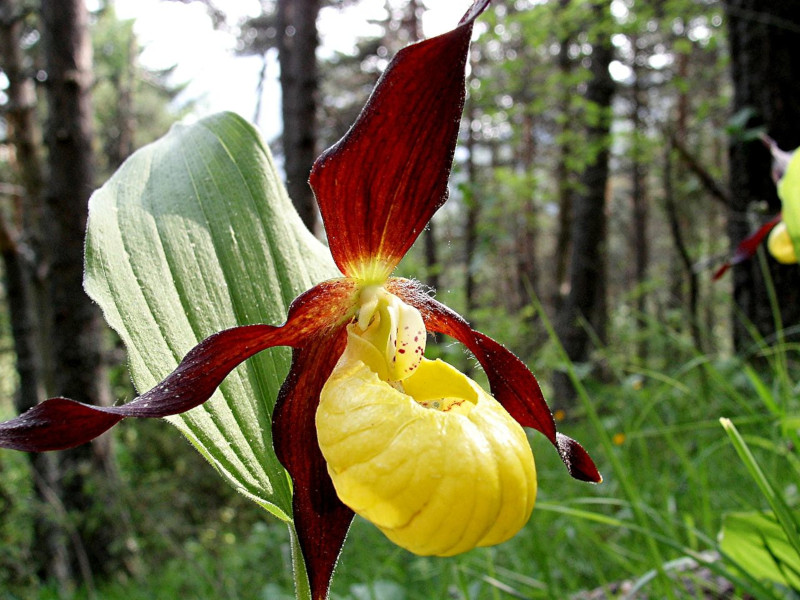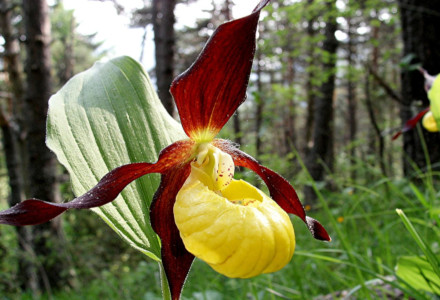
Cypripedium calceolus Facts
- The tongue-twisting term of Cypripedium calceolus serves as the official scientific name of a stunning variety of plant. Unfortunately for most of its fans, the magnificent orchid species currently has no generally accepted common name.
- The first recorded scientific description of this beautiful wonder of Nature occurred in Germany, in 1753. Later, the renowned Swedish botanist Carl Linnaeus became the first person to officially place it within a scientific classification.
- In fact, that official placement puts it in the Family collectively known as the Lady’s Slipper Orchid. Its particular appearance, however, often leads to its being confused with other, visibly similar species, at least by non-professional observers.
- Quite thankfully, for those who appreciate its beauty, the Cypripedium calceolus appears to be maintaining a sufficient and stable population base. The IUCN, therefore, lists the natural beauty as Least Concern on its Red List of Threatened Species.
- The gorgeous plant must, however, still be considered to be facing at least some risks to its continued existence. Though still abundant, human encroachment on its habitat could pose a threat in the future. Plus, it now faces the threat posed by climate change.
Related Articles
Cypripedium calceolus Physical Description
Regardless of its nearly impossible to pronounce name, the magnificent Cypripedium calceolus easily dazzles the eye. Yet it does not do so just because of its appearance, though that’s certainly lovely. It also represents one of the largest of the orchid varieties in its range.
The highly visually distinctive Angiosperm attains a height of as much as 23.6 in (60 cm). Along the length of its delicate, light-green colored stem, it further produces impressive foliage. Its 3 – 4 leaves also average 7.1 in (18 cm) in length, and 3.5 in (9 cm) in width.
Each individual plant typically produces 1 -2 of its spectacular blooms. These themselves also stand out for more than just their undeniable beauty, since they’re also somewhat larger than many of their relatives. More precisely, these average about 3.5 in (9 cm) in width.
Its the color scheme of the awesome Cypripedium calceolus that truly stands out, however. Its long, frequently slightly twisted, petals vary from reddish-brown to black, but may occasionally be green. It also has a large, slipper-shaped labellum, with red dots.
- Kingdom: Plantae
- Phylum: Angiosperms
- Class: Monocots
- Order: Asparagales
- Family: Orchiaceae
- Genus: Cypripedium
- Species: C. calceolus
Cypripedium calceolus Distribution, Habitat, and Ecology
Thankfully, the breathtaking Cypripedium calceolus possesses a remarkably wide distribution. In point of fact, it inhabits a relatively broad swathe of the world. This extensive range includes nearly every country in Europe, and also many of those in Asia, as well.
Quite sadly, its numbers have become severely diminished in the European portion of its range, in recent decades. In all parts of its range, though, it displays decided preferences for its habitat. The great majority of its numbers appear in temperate forests and shrubland.
Nonetheless, in its European range, the plant has adapted to another type of environment. This consists of areas of humus, over a limestone base, and within partially shaded woodlands. In all parts of its range, it lives at altitudes of no more than 6,890 ft (2,100 m).
For reasons that still elude researchers, the marvelous Cypripedium calceolus also frequently appears in association with another plant. A large percentage of its population grows in close proximity to stands of hazel trees, sometimes intermingling with them.
Like many of its related species, this wonder of Nature achieves its pollination via the action of a wide range of insets. The majority of these, though, seem to be formed of various species of bees. Meanwhile, it itself seems to be a popular food for slugs and snails.
Species Sharing Its Range
Check out our other articles on 4 Bulgarian Geological Marvels, Guinan cock-of-the-rock, White Witch Moth, Harbor Porpoise, Indian Bullfrog, Flatback Sea Turtle, Isle of Skye

